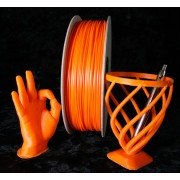Thermoplastics
The Best Choice for 3D Printing
Thermoplastics. In a recent article, we have
discussed the four major types of 3D
printing. However, we left the discussion of thermoplastics to this article,
which I find to be very interesting, which is why, I decided to create a
separate article for this one important aspect of 3D printing.
Little do most of us know that thermoplastics dominate several aspects of our everyday life. In fact, a lot of consumer products you see in the market today are made of this material.
Thermoplastics in 3D printing is likewise prevalent. For this, machines employing Fused Deposition Modeling (FDM) are used. Here, engineers may choose to make items using the most popular types of thermoplastics, namely ABS, polycarbonate, different blends, also engineered thermoplastics which are highly common among products use in aerospace, medicine, automotive, and electronics. 3D printing for finished goods uses thermoplastics, and so far, it’s the only choice for these applications.
Fred Fischer of Stratasys, Inc. writes that “materials characterize manufacturing processes.” In return, these processes also make up the composition of material properties present in the final product. The same can be said about additive manufacturing. Here, technologies are using these materials while the quality of the results ('finished product') is determined by the processes employed during manufacturing. In FDM, the materials used are industrial grade thermoplastics. High-performance engineered thermoplastics is one of them.
In additive manufacturing, a process of layering materials is performed to convert computer models into plastic parts. CAD files are directed to automated machines, which “layer” the materials, which in turn enable the production of complex parts. The FDM process results in functional parts by extruding and depositing the materials.
The very same raw materials are
being used at injecting molding facilities around the globe. Here, FDM
produces plastic parts contain elements that are highly suitable for
applications ranging from concept modeling to designing, in developing and
manufacturing products. Molded items, on the other hand, are available using
different types of materials. Each has its own characteristic to match whatever
application needs to be produced.
CHOOSING A THERMOPLASTIC
Choosing a specific type of thermoplastic, though, has to be done with careful consideration with regards to the mechanical, thermal, electrical and chemical properties involved. You also have to think of the changes in the environment due to aging or environmental exposure. Nonetheless, since a lot of pieces created using an FDM machine have the same characteristics and features thermoplastics have, it’s really up to you to decide what you really want.
For the likes of functional prototypes, patterns, tooling, manufacturing aids, and other applications, the process of picking the best should be more simple. All you need is to have a great level of understanding of the features that make every FDM in 3dDprinting, truly an excellent choice. Among the things that you have to consider include:
•Types of materials and characteristics
•Availability of FDM availability
•Support material type
•Color
Orange_Delight 500g ABS filament -- Click HerePimpin Purple 500g ABS filament
Royal Blue 500g ABS filament
Silver 500g ABS filament
Silver 1kg ABS filament
Gold 500g ABS filament

